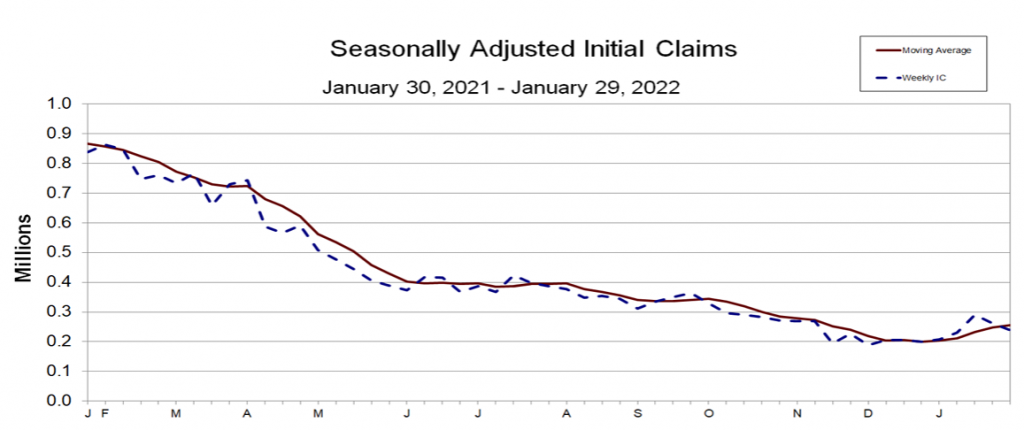
As we’re coming up on almost two years since the COVID-19 epidemic reached the United States, with its concurrent economic disruption, what are the unemployment insurance statistics in the U.S. for 2021, and what predictions do economist have for 2022?
A look back at 2021’s Unemployment Insurance Statistics
After a bump in December 2020 caused by the emergence of the Delta variant in the United States, unemployment rates across the country continued their gradual decline throughout 2021. They are now down to almost pre-pandemic levels.
According to the Bureau of Labor Statistics (BLS), the unemployment rate declined by 0.3% to 3.9% in December, with the number of unemployed persons decreasing by 483,000 to 6.3 million. “Over the year, these measures are down by 2.8 percentage points and 4.5 million, respectively,” the agency noted. In comparison, in February 2020, just before the coronavirus pandemic started in the United States, the unemployment rate was 3.5%, and the number of unemployed persons was 5.7 million, the agency said.

While this is still higher than pre-pandemic rates, that’s quite a change from April 2020, when the unemployment rate reached 14.8%. December also marks the first time since the pandemic that the unemployment rate fell below 4%.
Several other unemployment statistics also showed signs of returning to their pre-pandemic level, the BLS noted. For example, the number of permanent job losers, at 1.7 million in December, declined by 202,000 over the month and was down by 1.8 million over the year. The number of persons on temporary layoff was little changed at 812,000 in December but was down by 2.3 million over the year. Consequently, the number of permanent job losers in December is 408,000 higher than in February 2020, while the number on temporary layoff had essentially returned to its February 2020 level, the agency said.
That said, some people lost their jobs to COVID-19 that just didn’t get them back again. The number of long-term unemployed (those jobless for 27 weeks or more) declined by 185,000 to 2 million in December, the BLS said. While this measure is down from 4 million a year earlier, it is still 887,000 higher than in February 2020. Notably, the long-term unemployed accounted for 31.7% of the total unemployed in December, the agency said.
Similarly, some of the people who left the labor force during COVID-19 haven’t come back again. The labor force participation rate was unchanged at 61.9% in December but remains 1.5 percentage points lower than in February 2020, according to the BLS. The employment-population ratio increased by 0.2% to 59.5% in December, but is 1.7 percentage points below its February 2020 level. Over the year, these measures have increased by 0.4 and 2.1 percentage points, respectively.
Over the year, many people who had previously been employed part-time for economic reasons decreased – in fact, this figure is now below its pre-pandemic level, the BLS said. “These individuals, who would have preferred full-time employment, were working part time because their hours had been reduced or they were unable to find full-time jobs,” the agency explained. The number of persons employed part time for economic reasons, at 3.9 million in December, decreased by 337,000 over the month. The over-the-year decline of 2.2 million brings this measure to 461,000 below its February 2020 level.
Finally, the number of persons not in the labor force, but who currently want a job, was little changed at 5.7 million in December, the BLS said. These individuals were not counted as unemployed because they were either not actively looking for work during the four weeks preceding the survey, or were unavailable to take a job, the agency explained. This measure decreased by 1.6 million over the year but is still 717,000 higher than in February 2020.
On a state level, unemployment rates were lower in December in 42 states and the District of Columbia and stable in eight states, according to the BLS. Over the year, 48 states and the District added nonfarm payroll jobs and two states were essentially unchanged, the agency said.
What about 2022’s Unemployment Insurance Data?
Economists are predicting that, by the end of 2022, the United States jobless rate will have fully recovered from the pandemic.
“Experts polled for Bankrate’s Fourth-Quarter Economic Indicator survey see the unemployment rate dropping to 3.8% when 2022 concludes,” wrote Bankrate. “Meanwhile, economists forecast that U.S. employers will add an average of 292,000 new positions each month over the course of this year. To be sure, that projection reflects a slowdown in job creation, with firms creating about 484,000 new positions each month between December 2020 and November 2021. Yet, if that forecast plays out, the job market will have reached a significant milestone: about 98% of its 22.4 million pandemic-era job losses will be restored.”
What’s holding employment back? COVID fears, Bankrate said. “About 2.4 million people are still missing from the labor force, according to Labor Department data,” the publication wrote. “That weighs on job creation, as experts say those workers are staying on the sidelines out of fear of catching the virus.”
J.P. Morgan chief U.S. economist Michael Feroli predicted unemployment rates even lower, about 3%.
What about on a state level? In Texas, for example, the Federal Reserve Bank of Dallas predicted that estimate that jobs will increase 3% in 2022. “Based on the forecast, 389,300 jobs will be added in the state this year, and employment in December 2022 will be 13.4 million,” the organization said.
In comparison, in Arkansas, the state is projected to add 20,000 jobs this year, said Mervin Jebaraj, director of the Center for Business and Economic Research, in a panel discussion. The state added 27,000 jobs in 2021 after losing 38,000 jobs in 2020, he added. In fact, the state’s unemployment rate of 3.1% is so low that it might hampering economic growth, according to Axios.
Ironically, a post-Great Recession economic prediction from the BLS in 2003 predicted, “The unemployment rate is projected to gradually decrease to 5.4%, accompanied by a gain in household employment of 12.3 million jobs.” So even with the pandemic, which obviously nobody could have predicted, the United States is doing better than economists expected a decade ago.





